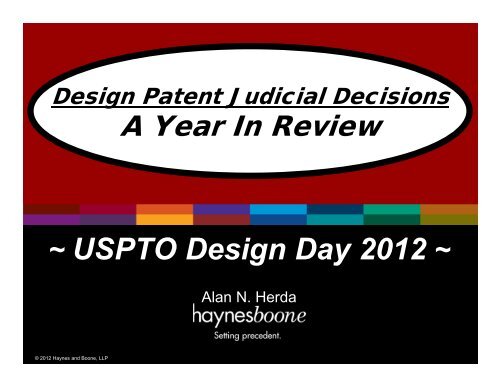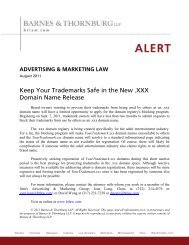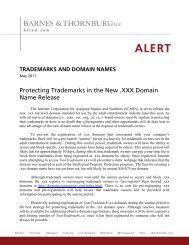USPTO-Judicial-Decisions-Review.pdf - Haynes and Boone, LLP
USPTO-Judicial-Decisions-Review.pdf - Haynes and Boone, LLP
USPTO-Judicial-Decisions-Review.pdf - Haynes and Boone, LLP
You also want an ePaper? Increase the reach of your titles
YUMPU automatically turns print PDFs into web optimized ePapers that Google loves.
Design Patent <strong>Judicial</strong> <strong>Decisions</strong>A Year In <strong>Review</strong>~ <strong>USPTO</strong> Design Day 2012 ~Alan N. Herda© 2012 <strong>Haynes</strong> <strong>and</strong> <strong>Boone</strong>, <strong>LLP</strong>
Lightning Fast <strong>Review</strong> ofCurrent Design Patent Law…• Design patent infringement– Claim Construction– Comparison of Construed Claim toAccused Design• Design patent invalidity– Functionality– Anticipation– Obviousness© 2012 <strong>Haynes</strong> <strong>and</strong> <strong>Boone</strong>, <strong>LLP</strong>
Lightning <strong>Review</strong> Design Patent Infringement:Claim CONSTRUCTION– “[A] design is better represented by an illustration ‘than it could be by any description <strong>and</strong>a description would probably not be intelligible without the illustration.’”– “[T]he preferable course ordinarily will be for a district court not to attempt to ‘construe’ adesign patent claim by providing a detailed verbal description of the claimed design.” (The“decision to issue a relatively detailed claim construction will not be reversible error.”)– “A court may find it helpful to point out … various features of the claimed design as theyrelate to the accused design <strong>and</strong> the prior art.”– “[A] trial court can usefully guide the finder of fact by addressing a number of other issuesthat bear on the scope of the claim [including:]– distinguishing between those features of the claimed design that are ornamental<strong>and</strong> those that are purely functional, see Oddzon Prods., Inc. v. Just Toys, Inc.,122 F.3d 1396, 1405 (Fed. Cir. 1997) (“Where a design contains bothfunctional <strong>and</strong> non-functional elements, the scope of the claim must beconstrued in order to identify the non-functional aspects of the design asshown in the patent.”).”Egyptian Goddess, Inc. v. Swisa, Inc., 543 F.3d 665 (Fed. Cir. 2008)© 2012 <strong>Haynes</strong> <strong>and</strong> <strong>Boone</strong>, <strong>LLP</strong>
Lightning <strong>Review</strong> Design Patent Infringement:COMPARISON of Claimed <strong>and</strong> Accused Designs!!• The ordinary observer test is the sole test for determiningwhether a design patent has been infringed. EgyptianGoddess, Inc. v. Swisa, Inc., 543 F.3d 665 (Fed. Cir. 2008).• The O.O.T.: “[I]f, in the eye of an ordinary observer, giving such attention as apurchaser usually gives, two designs are substantially the same, if theresemblance is such as to deceive such an observer, inducing him to purchaseone supposing it to be the other, the first one patented is infringed by the other.”Gorham Co. v. White, 81 U.S. 511 (1871).• Back to Egyptian Goddess:– “In other instances, when the claimed <strong>and</strong> accused designs are not plainlydissimilar, resolution of the question whether the ordinary observer wouldconsider the two designs to be substantially the same will benefit from acomparison of the claimed <strong>and</strong> accused designs with the prior art, asin many of the cases discussed above <strong>and</strong> in the case at bar.”© 2012 <strong>Haynes</strong> <strong>and</strong> <strong>Boone</strong>, <strong>LLP</strong>
“[W]hen the claimed <strong>and</strong> accused designs are not plainly dissimilar,resolution of the question whether the ordinary observer wouldconsider the two designs to be substantially the same will benefit froma comparison of the claimed <strong>and</strong> accused designs with the prior art.”• Four “Elements”AccusedDesignPriorArtOrdinaryObserverClaimedDesign© 2012 <strong>Haynes</strong> <strong>and</strong> <strong>Boone</strong>, <strong>LLP</strong>
Lightning <strong>Review</strong> Design PatentInvalidity• Invalidity based on functionality:– “To qualify for protection, a design must present an aesthetically pleasingappearance that is not dictated by function alone.” Bonito Boats, Inc. v.Thunder Craft Boats, Inc., 489 U.S. 141, 148 (1989).• Invalidity based on anticipation:– “[D]esign patent anticipation requires a showing that a single prior artreference is ‘identical in all material respects’ to the claimed invention.”Door-Master Corp. v. Yorktowne Inc., 256 F.3d 1308, 1312 (Fed. Cir. 2001).– But what about: “[T]he ordinary observer test must logically be the soletest for anticipation.” Int’l Seaway Trading Corp. v. Walgreens Corp., 589F.3d 1233, 1240 (Fed. Cir. 2009).– “identical in all material respects” = “substantially the same” ???See Saidman, 83 PTCJ 278, 12/23/2011.© 2012 <strong>Haynes</strong> <strong>and</strong> <strong>Boone</strong>, <strong>LLP</strong>
Lightning <strong>Review</strong> Design Patent Invalidity• Invalidity based on obviousness:• In re Rosen, 673 F.2d 388 (C.C.P.A. 1982)– “If this inquiry is to be made under 35 USC 103, it has recently been held by this court thatthe proper st<strong>and</strong>ard is whether the design would have been obvious to a designer ofordinary skill of the articles involved.”– “In considering patentability of a proposed design the appearance of the design must beviewed as a whole, as shown by the drawing, or drawings, <strong>and</strong> compared with somethingin existence -- not with something that might be brought into existence by selectingindividual features from prior art <strong>and</strong> combining them.”– “Thus there must be a reference, a something in existence, the design characteristics ofwhich are basically the same as the claimed design in order to support a holding ofobviousness.– “While a § 103 rejection of a claimed design need not be based on a single reference, … thelong-st<strong>and</strong>ing test for the proper combination of references has been ‘whether they are sorelated that the appearance of certain ornamental features in one would suggest theapplication of those features to the other.’”• But what about: Int’l Seaway Trading Corp. v. Walgreens Corp., 589F.3d 1233, 1240 (Fed. Cir. 2009)– “For design patents, the role of one skilled in the art in the obviousness context lies only indetermining whether to combine earlier references to arrive at a single piece of art forcomparison with the potential design or to modify a single prior art reference. Once thatpiece of prior art has been constructed, obviousness, like anticipation, requires applicationof the ordinary observer test, not the view of one skilled in the art.”See Saidman, 83 PTCJ 278, 12/23/2011.© 2012 <strong>Haynes</strong> <strong>and</strong> <strong>Boone</strong>, <strong>LLP</strong>
The year in review begins…Moose Mountain Toymakers Ltd. v. Majik Ltd., LLCNo. 10-4934 (D. N.J. Aug. 12, 2011)Claimed DesignAccused DesignInfringement?© 2012 <strong>Haynes</strong> <strong>and</strong> <strong>Boone</strong>, <strong>LLP</strong>
Moose Mountain Toymakers Ltd. v. Majik Ltd., LLCNo. 10-4934 (D. N.J. Aug. 12, 2011)Claim Construction•“Accordingly, each of the Patents will be reviewed <strong>and</strong> the Court will distinguish thefunctional elements from those that are ornamental.”•“Functional aspects” include: alley apron, alley side rails, sleeves, pins, enclosure, ballreturn track <strong>and</strong> game controller or console.•“Once these functional elements are discounted, the remaining ornamental features are:(1) the rectangular shape of the enclosure (2) the rounded alley side rails; <strong>and</strong> (3) theintermittent spacing of the sleeves of the alley apron within which the rounded alley side railsare received; <strong>and</strong> (4) the particular rectangular shape of the game console.”Accused infringers:use the “functional”sword to divide thedesign!© 2012 <strong>Haynes</strong> <strong>and</strong> <strong>Boone</strong>, <strong>LLP</strong>
Moose Mountain Toymakers Ltd. v. Majik Ltd., LLCNo. 10-4934 (D. N.J. Aug. 12, 2011)Comparison: NO infringement!Motion for Judgment on the Pleadings granted – no design patentinfringementImages from AccusedInfringer’s Motion forJudgment on the PleadingsWhat about prior art?© 2012 <strong>Haynes</strong> <strong>and</strong> <strong>Boone</strong>, <strong>LLP</strong>
Revision Military, Inc. v. Balboa Mfg. Co.2011 U.S. Dist. Lexis 98801 (D. Vt. Aug. 31, 2011)ClaimedDesignInfringement?AccusedDesignClaim Construction: the “patent describes goggles depicted in the six drawingscontained in the … patent.” unite the design?© 2012 <strong>Haynes</strong> <strong>and</strong> <strong>Boone</strong>, <strong>LLP</strong>
Revision Military, Inc. v. Balboa Mfg. Co.2011 U.S. Dist. Lexis 98801 (D. Vt. Aug. 31, 2011)Not likely to prove design patent infringement!Burden for proffering clear <strong>and</strong> convincing evidence not met – motion for preliminary injunction denied.Comparison: “Patented design <strong>and</strong> the design of the article sold by the patentee are substantially thesame, it is not error to compare the patentee’s <strong>and</strong> the accused articles directly.”“Although the court reaches this conclusion by examining the overall design of the goggles <strong>and</strong> not onan element-by-element basis, it notes that several design features st<strong>and</strong> out as dissimilar” namely:Shapes of the lenses (could not fit); Bridges; <strong>and</strong> shapes of vents <strong>and</strong> quantities of rows of vents.Prior art“decidedlyscant”“Not aparticularlyclose case”The “courtdoes notneed priorart.”Accused infringers:Divide the design!© 2012 <strong>Haynes</strong> <strong>and</strong> <strong>Boone</strong>, <strong>LLP</strong>
Victor Stanley, Inc. v. Creative Pipe, Inc.2011 U.S. Dist. Lexis 112846 (D. Md. Sept. 30, 2011)Claim Construction: “Assuggested by the Federal Circuit,the Court construed the designpatent claim by examining theillustrations in the patent <strong>and</strong> theaccused products. The Court alsoconsidered, for backgroundpurposes, testimony from [theinventor of the claimed design], whohad experience with the sitefurnishings marketplace, includingbench end frames <strong>and</strong> prior art, <strong>and</strong>with purchasers of site furnishings.”Prior Art© 2012 <strong>Haynes</strong> <strong>and</strong> <strong>Boone</strong>, <strong>LLP</strong>
Victor Stanley, Inc. v. Creative Pipe, Inc.2011 U.S. Dist. Lexis 112846 (D. Md. Sept. 30, 2011)Comparison: Infringement!Bench trial – finding of design patent infringement.“The overall design impression <strong>and</strong> effect of the [prior art] is distinctly different from that … claimed in thePatent.” “There are minor differences … [b]ut the [1 st accused design] so nearly resembles that of the[claimed design] that an ordinary observer, familiar with prior art designs, would be unable to easily distinguishthem in a side-by-side comparison without unusually careful effort.” (Design patentees: unite the design! )ClaimedDesign1 st AccusedDesignPrior Art© 2012 <strong>Haynes</strong> <strong>and</strong> <strong>Boone</strong>, <strong>LLP</strong>
Victor Stanley, Inc. v. Creative Pipe, Inc.2011 U.S. Dist. Lexis 112846 (D. Md. Sept. 30, 2011)Claimed Design2 nd Accused DesignInfringement?© 2012 <strong>Haynes</strong> <strong>and</strong> <strong>Boone</strong>, <strong>LLP</strong>
Victor Stanley, Inc. v. Creative Pipe, Inc.2011 U.S. Dist. Lexis 112846 (D. Md. Sept. 30, 2011)Comparison: NO infringement!Bench trial – no finding of design patent infringement.Claimed Design2 nd Accused DesignA infringes A,butA+B does notinfringe AAAB“The [2 nd accused design] has an added second brace <strong>and</strong> an oval below the arm rest. …The overall effect of the design with the oval below the seat, while certainly taking advantageof the graceful curves designed into the [claimed design], creates a different <strong>and</strong> distinctivelook that would not confuse the ordinary observer. Each of the individual ornamental elementsmay be almost identical in isolation, but the overall impression is aesthetically different.”Prior Art? Design Patent covering 2 nd Accused Design? “relevant but not dispositive”Accused infringers: add to the design! And apply for patents on your own designs!© 2012 <strong>Haynes</strong> <strong>and</strong> <strong>Boone</strong>, <strong>LLP</strong>
Seirus Innovative Accessories, Inc. v. Cabela’s, Inc.2011 U.S. Dist. Lexis 123697 (S.D. Cal. Oct. 25, 2011)Claimed DesignAccused DesignInfringement?© 2012 <strong>Haynes</strong> <strong>and</strong> <strong>Boone</strong>, <strong>LLP</strong>
Seirus Innovative Accessories, Inc. v. Cabela’s, Inc.2011 U.S. Dist. Lexis 123697 (S.D. Cal. Oct. 25, 2011)Claim Construction: the “ornamental designfor a neck protector as reflected in Figures 1-8, depicting a vertical zipper.” (in partbecause prior art discloses angled zipper)ClaimedDesignPrior Art© 2012 <strong>Haynes</strong> <strong>and</strong> <strong>Boone</strong>, <strong>LLP</strong>
Seirus Innovative Accessories, Inc. v. Cabela’s, Inc.2011 U.S. Dist. Lexis 123697 (S.D. Cal. Oct. 25, 2011)Comparison: No Infringement!ClaimedDesignAccusedDesignPrior Art“Both the [accused design] <strong>and</strong> the [prior art] have adiagonal zipper. In contrast, the [claimed design] islimited to a design with a vertical zipper.”Motion for summary judgment on noninfringement granted.(Accused infringers: divide the design (at claim construction, at comparison))!© 2012 <strong>Haynes</strong> <strong>and</strong> <strong>Boone</strong>, <strong>LLP</strong>
Apple, Inc. v. Samsung Electronics Co., Ltd., 2011 U.S. Dist. Lexis 139049 (N.D. Cal. Dec. 2, 2011)ClaimedDesignAccusedDesignInfringement?© 2012 <strong>Haynes</strong> <strong>and</strong> <strong>Boone</strong>, <strong>LLP</strong>
Apple, Inc. v. Samsung Electronics Co., Ltd., 2011 U.S. Dist. Lexis 139049 (N.D. Cal. Dec. 2, 2011)Design patent infringement likely, but substantialquestion regarding validity!Motion for preliminary injunction denied.“[T]he Court finds that Apple islikely to establish at trial thatthe [accused design] issubstantially similar to the[claimed design] in the eyes ofan ordinary observer.”ClaimedDesignPriorArt“Samsung has raised asubstantial question regardingthe validity of the [claimeddesign] on obviousnessgrounds.”“[Prior art] creates basicallythe same visual impressionas the [claimed design].”(flat glass surface absent, butdisclosed in other art)© 2012 <strong>Haynes</strong> <strong>and</strong> <strong>Boone</strong>, <strong>LLP</strong>
Apple, Inc. v. Samsung Electronics Co., Ltd., 2011 U.S. Dist. Lexis 139049 (N.D. Cal. Dec. 2, 2011)PriorArtClaimedDesignClaimedDesignAccusedDesignAccusedDesign6 embodiments1 embodimentLikelihood ofinfringement?Substantial questionregarding validity?© 2012 <strong>Haynes</strong> <strong>and</strong> <strong>Boone</strong>, <strong>LLP</strong>
Apple, Inc. v. Samsung Electronics Co., Ltd., 2011 U.S. Dist. Lexis 139049 (N.D. Cal. Dec. 2, 2011)No infringement findings becausemay beanticipated by:.Eachof<strong>and</strong>mostlikelyinfringes.Design patentees:apply for multipledesign patentshaving claims ofvarying scope!© 2012 <strong>Haynes</strong> <strong>and</strong> <strong>Boone</strong>, <strong>LLP</strong>
Rip-It Holdings, LLC v. Wilson Hunt Int’l2012 U.S. Dist. Lexis 4490 (M.D. Fla. Jan. 13, 2012)Claimed DesignAccused DesignInfringement?© 2012 <strong>Haynes</strong> <strong>and</strong> <strong>Boone</strong>, <strong>LLP</strong>
Rip-It Holdings, LLC v. Wilson Hunt Int’l2012 U.S. Dist. Lexis 4490 (M.D. Fla. Jan. 13, 2012)Claim Construction? Infringement?Substantial question of invalidity due to functionality!Motion for preliminary injunction denied because of substantial question of invalidity <strong>and</strong> lack of proof that questionlacks substantial merit.“To qualify for protection, a design must present an aestheticallypleasing appearance that is not dictated by function alone.” BonitoBoats, Inc. v. Thunder Craft Boats, Inc., 489 U.S. 141, 148 (1989).Rip-It :•“However, the Federal Circuit has also recognized that ‘[i]n determiningwhether a design is primarily functional, the purposes of the particularelements of the design necessarily must be considered.’”•“The mere fact that each element of a design serves some functionalpurpose does not necessarily mean that the overall design is dictated byfunction, … but when the function of each element cannot be separatedfrom the overall design, it indicates that the entire design is dictated byfunction.”Invalidate by functionality by DIVIDING the design.Accused infringers: divide the design to blow it up!© 2012 <strong>Haynes</strong> <strong>and</strong> <strong>Boone</strong>, <strong>LLP</strong>
Famosa Corp. v. Gaiam Inc.No. 11-cv-05703 (S.D.N.Y. Feb. 22, 2012)Claimed DesignAccused DesignInfringement?© 2012 <strong>Haynes</strong> <strong>and</strong> <strong>Boone</strong>, <strong>LLP</strong>
Famosa Corp. v. Gaiam Inc.No. 11-cv-05703 (S.D.N.Y. Feb. 22, 2012)Comparison:Infringement!Partial summary judgment as toinfringement of claimed designgranted.Comparison: “[N]ot only are thedesigns substantially similar, they arenearly identical.”There’s hope!© 2012 <strong>Haynes</strong> <strong>and</strong> <strong>Boone</strong>, <strong>LLP</strong>
…the year in review ends.DesignPatenteesAccusedInfringers• UNITE to enforce designpatent!– UNITE at claimconstruction!– UNITE at comparison!• File multiple design patentapplications having claims ofvarying scope!• DIVIDE to avoid designpatent infringement!– DIVIDE at claimconstruction!– DIVIDE at comparison!• ADD to the claimed design!• File for design patents!• (But maybe divide when arguing againstanticipation or obviousness.)• (But maybe unite when asserting anticipationor obviousness.)© 2012 <strong>Haynes</strong> <strong>and</strong> <strong>Boone</strong>, <strong>LLP</strong>
Thank you!!!Alan Herdaalan.herda@haynesboone.com214-651-5924<strong>Haynes</strong> <strong>and</strong> <strong>Boone</strong>, <strong>LLP</strong>2323 Victory Avenue, Suite 700, Dallas, Texas 75219© 2012 <strong>Haynes</strong> <strong>and</strong> <strong>Boone</strong>, <strong>LLP</strong>




